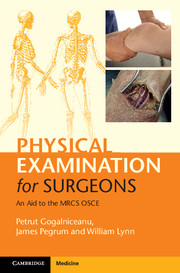Book contents
- Frontmatter
- Dedication
- Contents
- List of contributors
- Introduction
- Acknowledgments
- List of abbreviations
- Section 1 Principles of surgery
- Section 2 General surgery
- Section 3 Breast surgery
- Section 4 Pelvis and perineum
- Section 5 Orthopaedic surgery
- Section 6 Vascular surgery
- Section 7 Heart and thorax
- Section 8 Head and neck surgery
- Section 9 Neurosurgery
- Section 10 Plastic surgery
- 39 Examination of skin lesions and lumps
- 40 Examination of scars
- 41 Examination of flaps and grafts
- 42 Examination of burns
- 43 Examination of the hands
- Section 11 Surgical radiology
- Section 12 Airway, trauma and critical care
- Index
42 - Examination of burns
from Section 10 - Plastic surgery
Published online by Cambridge University Press: 05 July 2015
- Frontmatter
- Dedication
- Contents
- List of contributors
- Introduction
- Acknowledgments
- List of abbreviations
- Section 1 Principles of surgery
- Section 2 General surgery
- Section 3 Breast surgery
- Section 4 Pelvis and perineum
- Section 5 Orthopaedic surgery
- Section 6 Vascular surgery
- Section 7 Heart and thorax
- Section 8 Head and neck surgery
- Section 9 Neurosurgery
- Section 10 Plastic surgery
- 39 Examination of skin lesions and lumps
- 40 Examination of scars
- 41 Examination of flaps and grafts
- 42 Examination of burns
- 43 Examination of the hands
- Section 11 Surgical radiology
- Section 12 Airway, trauma and critical care
- Index
Summary
Acute burns
Checklist
WIPER
Physiological parameters
General
• Resuscitate patient.
• ITU support: airway, hydration, analgesia and antibiotics.
• Comment on dressings already applied.
Look
• Site of the burn
• Airway compromise risk factors: singed nasal hairs, perioral burns, blistered palate, swelling of tongue or naso-oral mucosa, hoarse voice due to laryngooedema, swollen uvula
• Percentage of total body surface area (TBSA) burnt
• Circumferential burns to chest or limbs
• Depth of burn:
• superficial (epidermal)
• superficial partial-thickness (superficial dermal)
• deep partial-thickness (deep dermal)
• full-thickness
• Assess any structure(s) involved at the base of the burn.
Feel
• Sensation/tenderness
• Capillary refill time in burn, peripheral and centrally
• Moist or dry burn
• Assess peripheral pulses
• Assess chest movements if any circumferential burns
• Identify compartment syndrome in circumferential limb burns
Move
• Movement of underlying joints
Old burns
Checklist
WIPER
Physiological parameters
General
• Tracheostomy scar
• Fitted pressure garments/splints
Look
• Site affected by the burn
• Extent of burn
• Burn and donor sites: graft/flap healing status, colour, contour, contracture, cosmetic result
Feel
• Burn and donor sites for healing result: thickness scars, texture, sensation, tenderness, pliability
Move
• Assess contraction of scars around joints, testing ROM.
• Assess functional impairment of local structures.
To complete the examination…
• Assess neurovascular status of loco-regional tissue involved.
Examination notes
What is a burn?
A burn is the coagulative necrosis of tissue due to a thermal, chemical, electrical, friction or radiation insult.
What are the guidelines for the management of burns?
Advanced Trauma Life Support (ATLS)
Emergency Management of Severe Burns (EMSB) principles
One must accurately assess the burn size and depth, as this will determine further specialist management.
- Type
- Chapter
- Information
- Physical Examination for SurgeonsAn Aid to the MRCS OSCE, pp. 367 - 370Publisher: Cambridge University PressPrint publication year: 2015

